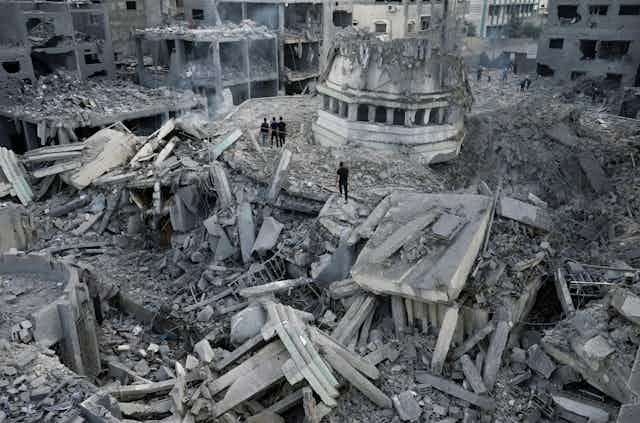Buildings are often celebrated as symbols of history, political events and creative expression. However, the simplest, most pure function of buildings is often forgotten: the way they fulfil needs and form memories.
For years, research has shown that buildings, people’s memories and everyday life are connected elements that form our attachment to a place and create our relationships to our “homeˮ. This triangle of connection helps us identify with places and feel like we belong somewhere.
Gaza has long been cherished as a sanctuary for creative experimentation, and as a place where resilient people strive to defy the violence of colonisation. Within this landscape of destruction and occupation, the locals have always tried to hold onto the concept of home, beyond a fleeting shelter that could vanish with the next bombing campaign.
However, this continuous cycle of destruction and hopeful reconstruction has now come to an abrupt halt. Since October 7 2023, the bombardment of Gaza is reported to have damaged more than 100 historic sites and destroyed 69,700 homes.
At the time of writing, 1.9 million Palestinians have been displaced. This ongoing urbicide – the destruction of cultural hubs in the built environment – also threatens that triangle connecting people to their homes, land and heritage.
With more than half of Gazaʼs buildings either damaged or destroyed, it is impossible to cover the immense changes to the lives of these Palestinians in one article. So, here are just three examples of these lost buildings, and how their destruction has affected the everyday lives of local people in Gaza.
The Great Omari Mosque
A reflection of Palestine’s history where multiple religions coexisted, the Great Omari Mosque has undergone multiple transformations throughout history.

Built on the site of a pagan temple, this fifth-century church became a mosque in AD635. With a courtyard area of 1,190m², the mosque was the second-largest in Palestine and served as a daily destination for more than 3,000 worshippers.
Situated near Palestine Square, it has played a crucial role in the everyday life of Gaza, as mosques in Middle Eastern cities foster social interactions, informal conversations and societal bonds. But this incubation of societal interactions came to an abrupt stop in December 2023, when the mosque was reduced to rubble.
Palestine Square
Palestine Square has long been the centre of everyday life in Gaza and is widely regarded as the heart of the city. It is significant due to its proximity to the Great Omari Mosque and many services, as well as the passage it provides to various markets.
Urban squares play a crucial role not only in facilitating transportation and passage but also as places that are connected to our identity, memories and how we perceive our city.
Therefore, targeting Palestine Square and completely destroying the surrounding buildings in January posed a threat to some fundamental aspects of people’s daily lives and their sense of belonging to the city.
Omar Al-Mukhtar Street
Often called the most important street in Gaza City, Omar Al-Mukhtar Street is one of its two main thoroughfares along with Al-Wihdi Street.
It serves as the city’s commercial centre and is home to the city hall and public library. However, on October 8 2023, the street became one of the first targets of Israeli airstrikes, abruptly ending the bustling commercial activities that so many people relied on.
This street was not only a place for Palestinian families to fulfil their everyday needs, but a hub for leisure and entertainment. For years, cultural sites like Omar Al-Mukhtar Street have fostered social bonds, preserved memories, and created societal bonds through everyday life and cultural events.
Seeing past the ashes
Gaza faces a challenging and lengthy path to recovery. These destroyed buildings serve as a reminder of the lost everyday life and rich cultural heritage hidden beneath the rubble.
The scale of destruction is immense, as is the humanitarian loss and disruption to daily life patterns. All will have long-lasting effects on the city’s identity and the local community’s heritage.
While it is important to highlight the destruction of buildings, it is even more crucial to shed light on how this affects everyday life and the functioning of the city. Gaza, once a hub of creative experimentation, now lies in ruins and urgently requires humanitarian, architectural and heritage support.
In this complex landscape, aid efforts should prioritise the restoration of physical structures that facilitate everyday life. Commercial spaces, urban squares, places of worship and homes formed a network that sustained daily life in Palestine.
When the bombing finally ends, it will be crucial to uncover and restore this network to restore Palestinians’ sense of belonging to their cities – and connection with their land.

Looking for something good? Cut through the noise with a carefully curated selection of the latest releases, live events and exhibitions, straight to your inbox every fortnight, on Fridays. Sign up here.

